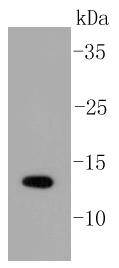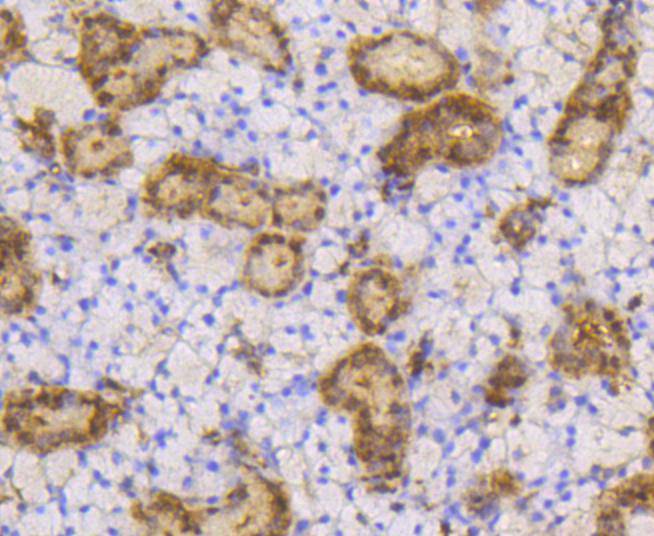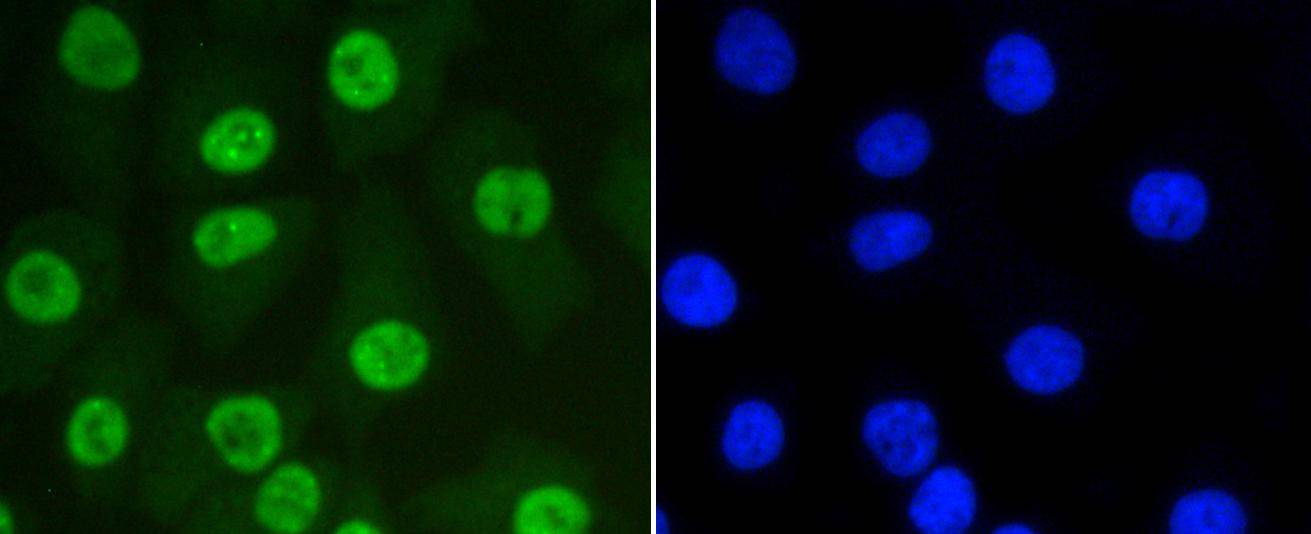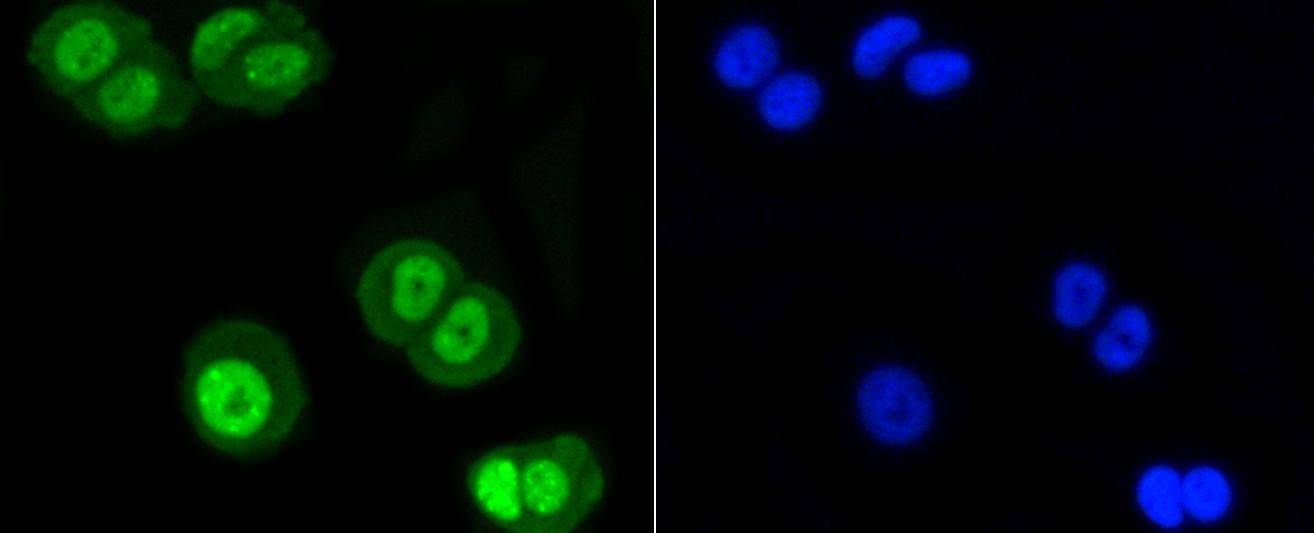Product Detail
Product NameSUMO-1 Rabbit mAb
Clone No.SJ20-03
Host SpeciesRecombinant Rabbit
Clonality Monoclonal
PurificationProA affinity purified
ApplicationsWB, ICC/IF, IHC, IP, FC, ChIP
Species ReactivityHu, Ms, Rt
Immunogen Descrecombinant protein
ConjugateUnconjugated
Other NamesDAP1 antibody
GAP modifying protein 1 antibody
GAP-modifying protein 1 antibody
GMP 1 antibody
GMP1 antibody
OFC10 antibody
PIC 1 antibody
PIC1 antibody
SENP2 antibody
Sentrin 1 antibody
Sentrin antibody
Small ubiquitin related modifier 1 antibody
Small ubiquitin-like modifier 1 antibody
Small ubiquitin-related modifier 1 antibody
SMT3 antibody
SMT3 homolog 3 antibody
SMT3 suppressor of mif two 3 homolog 1 antibody
SMT3, yeast, homolog 3 antibody
Smt3C antibody
SMT3H3 antibody
SUMO-1 antibody
SUMO1 antibody
SUMO1_HUMAN antibody
Ubiquitin homology domain protein PIC1 antibody
Ubiquitin Like 1 antibody
Ubiquitin like protein SMT3C antibody
Ubiquitin like protein UBL1 antibody
Ubiquitin-homology domain protein PIC1 antibody
Ubiquitin-like protein SMT3C antibody
Ubiquitin-like protein UBL1 antibody
UBL 1 antibody
UBL1 antibody
Accession NoSwiss-Prot#:P63165
Uniprot
P63165
Gene ID
7341;
Calculated MW12 kDa
Formulation1*TBS (pH7.4), 1%BSA, 40%Glycerol. Preservative: 0.05% Sodium Azide.
StorageStore at -20˚C
Application Details
WB: 1:1,000-1:2,000
IHC: 1:50-1:200
ICC: 1:50-1:200
FC: 1:50-1:100
Western blot analysis of SUMO-1 on Hela cell lysates using anti-SUMO-1 antibody at 1/1,000 dilution.
Immunohistochemical analysis of paraffin-embedded human tonsil tissue using anti-SUMO-1 antibody. Counter stained with hematoxylin.
Immunohistochemical analysis of paraffin-embedded human thyroid tissue using anti-SUMO-1 antibody. Counter stained with hematoxylin.
Immunohistochemical analysis of paraffin-embedded human breast carcinoma tissue using anti-SUMO-1 antibody. Counter stained with hematoxylin.
Immunohistochemical analysis of paraffin-embedded mouse thyroid tissue using anti-SUMO-1 antibody. Counter stained with hematoxylin.
Immunohistochemical analysis of paraffin-embedded mouse placenta tissue using anti-SUMO-1 antibody. Counter stained with hematoxylin.
ICC staining SUMO-1 in Hela cells (green). The nuclear counter stain is DAPI (blue). Cells were fixed in paraformaldehyde, permeabilised with 0.25% Triton X100/PBS.
ICC staining SUMO-1 in A549 cells (green). The nuclear counter stain is DAPI (blue). Cells were fixed in paraformaldehyde, permeabilised with 0.25% Triton X100/PBS.
ICC staining SUMO-1 in MCF-7 cells (green). The nuclear counter stain is DAPI (blue). Cells were fixed in paraformaldehyde, permeabilised with 0.25% Triton X100/PBS.
Flow cytometric analysis of Hela cells with SUMO-1 antibody at 1/50 dilution (blue) compared with an unlabelled control (cells without incubation with primary antibody; red). Alexa Fluor 488-conjugated goat anti rabbit IgG was used as the secondary antibody.
The small ubiquitin-related modifier (SUMO) proteins, which include SUMO-1, SUMO-2 and SUMO-3, belong to the ubiquitin-like protein family. Like ubiquitin, the SUMO proteins are synthesized as precursor proteins that undergo processing before conjugation to target proteins. Also, both utilize the E1, E2, and E3 cascade enzymes for conjugation. However, SUMO and ubiquitin differ with respect to targeting. Ubiquitination predominantly targets proteins for degradation, whereas sumoylation targets proteins to a variety of cellular processing, including nuclear transport, transcriptional regulation, apoptosis and protein stability. The unconjugated SUMO-1, SUMO-2 and SUMO-3 proteins localize to the nuclear membrane, nuclear bodies and cytoplasm, respectively. SUMO-1 utilizes Ubc9 for conjugation to several target proteins, which include IkBa, MDM2, p53, PML and Ran GAP1. SUMO-2 and SUMO-3 contribute to a greater percentage of protein modification than does SUMO-1, and unlike SUMO-1, they can form polymeric chains. In addition, SUMO-3 regulates b-Amyloid generation and may be critical in the onset or progression of Alzheimers disease.
If you have published an article using product 48765, please notify us so that we can cite your literature.












 Yes
Yes



